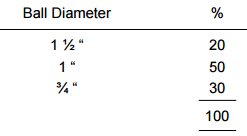The test is designed to give a reasonable indication of the grinding work index of an ore material relative to one or more known standards. It is not applicable to mill tailings material.
Basic Equipment
- Set of screens @ 75 to 2440 micron sizes.
- Ro-Tap Sieve Shaker
- Ball mill rolls
- CMS ball mill No.1 with approximately 10 kg of ball charge distributed as follows:
Procedure
- Crush the known and test samples to -3350 micron using either the jaw or rolls crusher.
- Riffle split the crushed sample. Weight out approximately 300 grams for feed sizing and exactly 1000 grams for grinding.
- For sizing feed:
-wet screen at 70µm and dry the product.
– dry screen the oversize (+75µm) on 2440, 1680, 1016, 600, 300, 150 and 75µm.
For grinding:
– place 1000 grams of the known sample in the ball mill, introduce the ball charge, add 625ml of water. Secure mill lid tightly and grind for 10 minutes.
- Wash the pulp thoroughly from the mill and the charge, wet screen the pulp @ 75 microns and dry product.
- Dry screen the oversize (+75µm) product on 1680, 850, 600, 425, 210, 106, 75µm.
- Plot feed and product sizings on a log-normal graph sheet as cumulative weight % passing versus particle size. Each particle size is determined by calculating the geometric mean size (GMS) of two successive screens used. For example, GMS of –3350 + 2440µm size range equals to:
(3350 x 2440µm)^0.5 = 2830µm
Repeat above procedure for the unknown sample.
Read off F80(µm) and P80(µm) from the plots and calculate the comparative grinding work index (CWi) of the unknown.
Note: F80= the diameter in micron which 80% of the feed weight passes.
P80 = the diameter in micron which 80% of the product weight passes.
Calculation
The formula to use is:
where R refers to the reference standard sample of known Wi and C refers to the unknown sample.
For the comparison to be valid, the following rules of thumb should be noted:
– Feed size distributions of the reference sample and unknown should ideally be similar.
– Grinding conditions must be identical.
– Ideally, comparative ores should have roughly similar grinding characteristics; that is, similar slope and shape in size distribution curves.
For example, hard siliceous ore and soft talcose ore are not compatible.
Although metallurgical testing may not start with grinding, intensive research must be conducted in this area since the power and media consumptions in grinding in an operating plant are frequently the most significant operating cost items in minerals beneficiation. The purpose of comminution is to affect adequate liberation of the desirable components from each other and from the waste so that subsequently, they may be separated efficiently by flotation or other processes. Grinding is the initial key variable to define and refine exceptions to this statement may be noted in the processing of potash and other non-metal lies, in handling extremely complex sulphide ores and in some of the less common ore treatment plants where expensive or large quantities of reagents are more costly than grinding. Therefore, as power, energy and material costs escalate, it behooves the metallurgist to develop the most economical comminution techniques.
In the early years of this modern milling era, the operators had but one choice of grinding media and method, i.e. balls in ball mills. Today, there is a wide range to select from. Broadly speaking, this, range includes fully autogenous, semi-autogenous, pebble, rod and ball milling and it is the responsibility of the metallurgical, research team to choose the most efficient type or combination of types. Grinding may be performed wet or dry, although, in the base metal, uranium and iron ore industries, wet methods are usually preferred for a number of reasons, chief of which may be the ease of handling, the possible effects on metallurgy and the environmental advantages.
The geologists, mineralogists and miners can assist the metallurgists to do the preliminary analyses on the ores to determine the potentials for some form of autogenous grinding. They will note . whether the ore is hard, soft, highly fractured, massive, weathered or blocky and many other significant features. If at least part of the grinding may be accomplished 1n this manner, the number of steps, the number of pieces of processing equipment including conveyors and the consumption of purchased grinding media could be lowered.

